ISTQB Advanced Level Test Analyst & Technical Test Analyst Exam – Sample Paper: Q. 41 to 50
Deep study of this set of 80 questions shall be of great help in getting success in ISTQB CTAL Advanced Level Test Analyst & Technical Test Analyst Exam. All these questions are based upon ISTQB Certified Tester Advanced Level Syllabus V 2007.
Set of 10 Questions (Q. 41 to 50)
Correct Answers of earlier Q. 31 to 40 are at the end of this page:
Q. 41: A software company developed a software application for a Life Insurance Company. The testers of the software company were given the release to test.
The software application calculates the annual life insurance cost based on customers’ age. Life insurance cost is as follows per year;
# Age 18
or less: US $ 300# Age over 18 or less than 70: US $ 500
# Person has to be at least 1 year old to purchase insurance
If a customer enters any other age, the software prints an error message. The Application accepts only positive integer values (no decimals).
How many test cases at minimum can you derive using both Boundary Value analysis and Equivalence partitioning to test the life insurance application?
A. 9
B. 10
C. 6
D. 3
Explanation in favor of the correct Answer:
Using Equivalence Partitioning (EP), (since the question does not mention valid/invalid partitions), we have to consider both.
EP tests: 0, 2, 20, 75 (two from valid partition and two from invalid partition.)
BV tests: 0, 1,2, 17,18,19, 69, 70, 71
Now let’s see the unique number of tests that we can get: 0, 1,2,17,18,19,69,70,71
So the total number of tests are: 9
Why did we ignore 20 and 75 ?
Because 20 and 19 both in the same valid partition and 19 is in the boundary. Therefore, we picked 19.
75 and 71 both in the same invalid partition and 71 is in the boundary. Therefore, we picked 71.
For getting the correct answer browse down to the end of this page
<<<<<< =================== >>>>>>
Q. 42: A Car sales company is financing their customers’ vehicles. Financing interest rates are as follows:
(I) For all motorcycles:
a) Customer Credit score 300 – 550
# Annual income US$ 40K-80K – Interest rate 15%
# Annual income US$ 81K-100K- Interest rate 12 %
# Annual income US $ 101K or more – Interest rate 9 %
b) Customer Credit score 551- 680
# Annual income US$ 40K-80K – Interest rate 12%
# Annual income US$ 81K-100K- Interest rate 9 %
# Annual income US $ 101K or more – Interest rate 7 %
c) Customer Credit score 681 or more
# Annual income US$ 40K-80K – Interest rate 10%
# Annual income US$ 81K-100K-Interest rate 6
# Annual income US $ 101K or more – Interest rate 5 %
(II) For all other vehicles the interest rate is 1 % less (from the values given above) for each category mentioned.
a) Ex: Customer Credit score 300 – 550
Annual income US$ 40K-80K – Interest rate 14% and so on.Select the correct decision table from the decision tables given below for the above scenario




<<<<<< =================== >>>>>>
Q. 43: A Car sales company is financing their customers’ vehicles. Financing interest rates are as follows:
(I) For all motorcycles:
a) Customer Credit score 300 – 550
# Annual income US$ 40K-80K – Interest rate 15%
# Annual income US$ 81K-100K- Interest rate 12 %
# Annual income US $ 101K or more – Interest rate 9 %
b) Customer Credit score 551- 680
# Annual income US$ 40K-80K – Interest rate 12%
# Annual income US$ 81K-100K- Interest rate 9 %
# Annual income US $ 101K or more – Interest rate 7 %
c) Customer Credit score 681 or more
# Annual income US$ 40K-80K – Interest rate 10%
# Annual income US$ 81K-100K-Interest rate 6
# Annual income US $ 101K or more – Interest rate 5 %
(II) For all other vehicles the interest rate is 1 % less (from the values given above) for each category mentioned.
a) Ex: Customer Credit score 300 – 550
Annual income US$ 40K-80K – Interest rate 14% and so on.
What is the minimum number of test cases required to test the above application? (Hint: derive test cases using decision table technique using the decision table described in Q. 42 above)
A. 9
B. 18
C. 20
D. 2
Explanation in favor of the correct Answer:
Count the number of columns in the correct decision table in Q.42 � Option -A to get the answer
For getting the correct answer browse down to the end of this page
<<<<<< =================== >>>>>>
Q. 44: Select the correct state transition diagram for the following train door open/close scenario. When the train is moving, the train doors are closed. After train stops at a station, doors will be opened by the operator, passengers take off and new passengers board the train. Doors will be opened for 40 seconds at the train station. Train doors will be closed when the train is not in service.
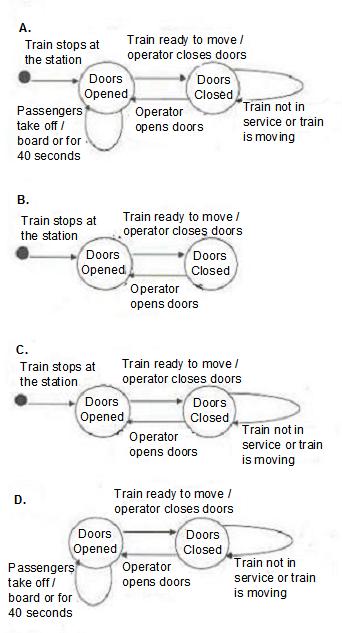
<<<<<< =================== >>>>>>
Q. 45: Each number represents a state in the following online shopping cart state transition diagram. Select the correct pair.
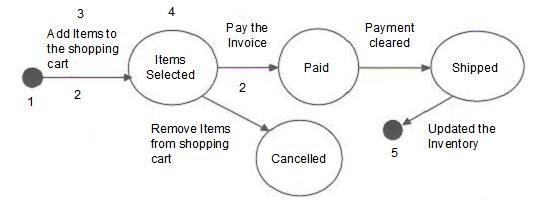
A. 1- Initial state, 2- event, 3 – transition, 4 – state, 5 – Final State
B. 1- Initial state, 2- event , 3 – states, 4 – transition, 5 – event
C. 1- Initial state, 2- transition, 3 – event, 4 – state, 5 – Final State
D. 1- Final state, 2- transition, 3 – event, 4 – state, 5 – Initial state
<<<<<< =================== >>>>>>
Q. 46: Use the following code;
x=1
y=2
z=3
If (x = = 2)
{
print “Hi There !”;
}
else
{
print “Good bye”;
}
z=x + y;
if (z ==4)
{
print “Welcome Back!”;
}
else
{
print “Thank you”;
}
How many test cases, at minimum, are required for statement coverage?
A. 4
B. 2
C. 3
D. 8
Explanation in favor of the correct Answer:
In this case, we need to find how many test cases are required to cover each statement of the code.
One of the ways to find that number is to draw a flow chart as follows;
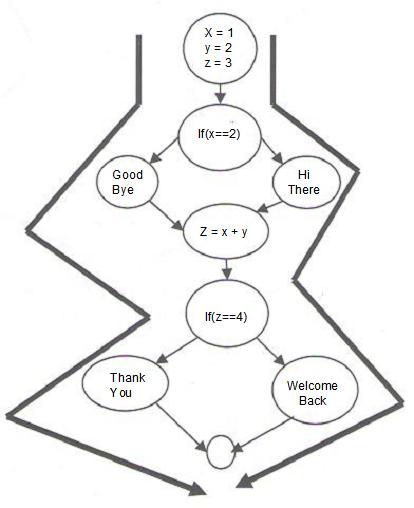
Nodes (circles) represent: each statement of the code Edges (lines) represent: links between the nodes (circles)
In statement coverage, you need to cover all the nodes (circles).
When looking at the above flow chart, we can see that 2 test cases are sufficient to cover the code (see the two bold lines).
For getting the correct answer browse down to the end of this page
<<<<<< =================== >>>>>>
Q. 47: Use the following code;
x=1
y=2
z=3
If (x = = 2)
{
print “Hi There !”;
}
else
{
print “Good bye”;
}
z=x + y;
if (z ==4)
{
print “Welcome Back!”;
}
else
{
print “Thank you”;
}
How many test cases at minimum are required to test branch / decision coverage?
A. 2
B. 3
C. 4
D. 1
Explanation in favor of the correct Answer:

To calculate the number of test cases required for branch coverage, you need to cover all the edges (lines).
So from the above flow chart, we can cover all the lines / edges with two test cases.
For getting the correct answer browse down to the end of this page
<<<<<< =================== >>>>>>
Q. 48: Use the following code;
x=1
y=2
z=3
If (x = = 2)
{
print “Hi There !”;
}
else
{
print “Good bye”;
}
z=x + y;
if (z ==4)
{
print “Welcome Back!”;
}
else
{
print “Thank you”;
}
How many test cases at minimum are needed to test the path coverage?
A. 2
B. 3
C. 4
D. 1
Explanation in favor of the correct Answer:
To calculate the number of test cases required for path coverage, you need to cover all paths in the program considering one decision at a time.
There are 3 ways to find the path coverage;
(1) Using McCabe’s technique.
Number of Paths = e – n + 2
e – Edges (lines)
n – Nodes (circles)
From the above example:
Number of Paths = 10 (lines) -9 ( circles) + 2 = 3
(2) Calculate the regions of the flow chart (area enclosed by lines is a region).
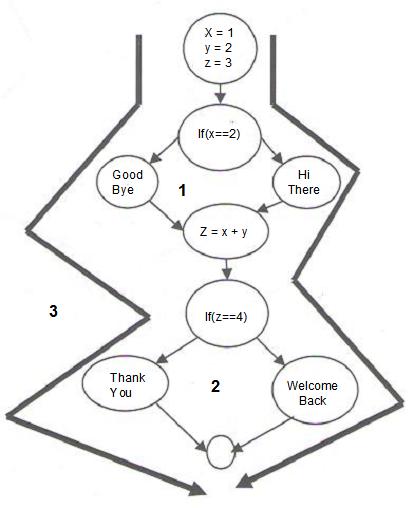
Always add outside region.So in this case, the number of paths = 3.
(3) Calculate the decisions (true/false, etc) in the flow chart
Number of Paths = Decisions + 1
There are two decision points in the above chart (if statements)
So the number of paths = 2 + 1 = 3
You can use one of the techniques and find the number of paths. It is better to confirm the answer by using another method. The key is to draw the flow chart correctly.
For getting the correct answer browse down to the end of this page
<<<<<< =================== >>>>>>
Q. 49: A College Enrollment application used by ABC College calculates the amount each student has to pay for gym and computer lab usage.
The application asks for Student ID, Name and Student’s major. Then the application calculates the fee. If student’s major is Computer Science, they have to pay the full computer lab fee. If the student’s major is not Computer Science, they have to pay only 1/3 rd of the computer lab fee. All students have to pay for the gym membership.
How many tests are required for path coverage of the above application?
A. 1
B. 2
C. 3
D. 10
Explanation in favor of the correct Answer:
You can draw the flow chart as follows:
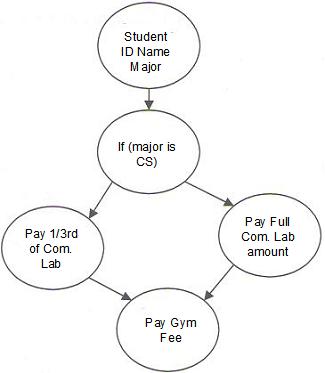
So, using the first method;Number of paths = e-n+2 = 5-5+2 = 2
You can confirm the answer using one of the other two methods mentioned above.
For getting the correct answer browse down to the end of this page
<<<<<< =================== >>>>>>
Q. 50: Consider the following perl code;
$x = 100;
If ($account > 100)
{
for ($deposit = 1 ; $deposit > 3 ; $deposit ++)
{$x=$x+1;
}
if ($account <= 100)
{
for ($withdraw = 0; $withdraw > 2 ; $withdraw ++)
{
$x=$x-1;
}
}
$x=$x+100;
How many test cases at a minimum are needed to test the path coverage?
A. 6
B. 5
C. 4
D. 3
Explanation in favor of the correct Answer:
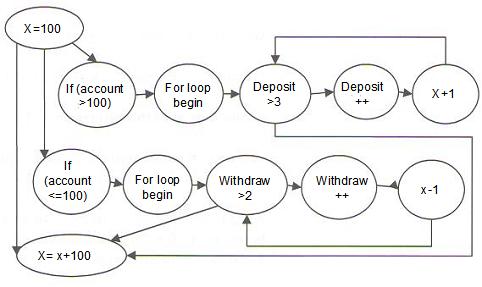
Path coverage: e – n + 2 = 15-12 +2 = 5
For getting the correct answer browse down to the end of this page
Correct Answers of the above Questions
Access the Full Database of All Questions
Correct Answers to Earlier Questions – Q. 31 to Q 40 are as under:
| Question No. | Correct Answer |
| Q. 31 | B |
| Q. 32 | C |
| Q. 33 | C |
| Q. 34 | C |
| Q. 35 | B |
| Q. 36 | C |
| Q. 37 | A |
| Q. 38 | A |
| Q. 39 | D |
| Q. 40 | A |

An expert on R&D, Online Training and Publishing. He is M.Tech. (Honours) and is a part of the STG team since inception.
